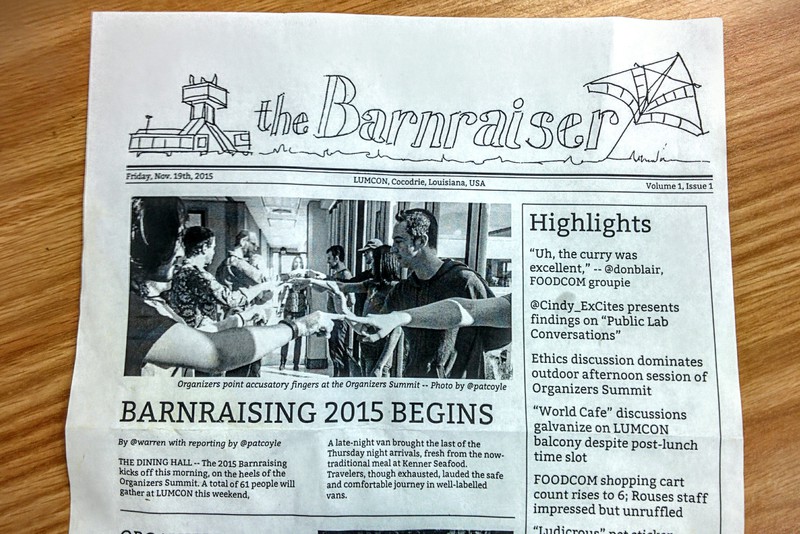
The Barnraiser
The Barnraiser is a 1-page daily "newspaper" we're publishing during the PL Barnraising as part of the Documentation Committee (DocCom). We see it as a lighthearted (but hard-hitting journalistic) way to summarize and share in a succinct, low-burden, but regular way, what's going on at our busiest and most productive event of the year!
Recruiting reporters & editors
Email jeff@publiclab.org and/or plots-barnraising@googlegroups.com to become a reporter or editor! Despite limited page space, we're happy for any help we can get!
Publishing
We'll use the talk page of this wiki page as a (chaotic) staging area to collect material and links over the course of each day. Please dump content there with your name.
We're planning on doing a digital layout using Google Drawings (for now), and the template is here. Please make a copy of the template and paste the link in here for each issue:
- Issue 1:
Reporters
Current reporters include @marlokeno, @patcoyle and @kanarinka.
Resources
Logos, graphics: barnraiser.svg and barnraiser.png
Photos
Feel free to upload photos here for upcoming issues; click "edit" and drag and drop them in:
After activities, the suggestion was to move onto actionable outcomes reports, victories.
@lizbarry: GLAMstuff: Gowanus bacterial reporting led to expansion of Superfund scope and area.
Also, "dead body" park resulting in actions to reduce sewage release into canal. Interesting twist on advocacy.
Gretchen: aerial imagery revealed violations like washing vehicle with runoff into canal, led to legal actions which curtailed activities.
Mathew noted conference where people used Google Street view to find and report violations and lawsuits with results.
Stevie noted dust and sand mine visibility on what is not working
Mathew noted may need to consider shift in focus to what can monitor with more actionable outcome vs other aspects
Liz noted bucket monitoring with big win. Certain samples can bring big results in getting funding and regulatory movement.
Likewise at nuclear reactor, thermal water monitoring as part of broader concerns.
Nick: in formaldehyde monitoring useful to ask regulators what is of most interest to them so can focus on those stories. Also Gretchen noted from Wisconsin trip, regulator suggested take photo of, for example, dirty water, it can be enough to get them to initiate actions (time stamped and geoloacated) are good evidence.
Jeff suggested make list of examples:
Gretchen also thought of cameras actuated when sensors detect spike. Liz noted also by other project team.
Don Blair noted in Columbia, re: mining pollution concerns, folks thought if could set up monitors that could increase visibility.
Mathew noted re: sand mining, even with poor sensors and suggestive data put pressure on regulators to make company install better sensors, although installed on upwind side of facility.
Gretchen is POC to get these stories shared.




